Browning potato digger
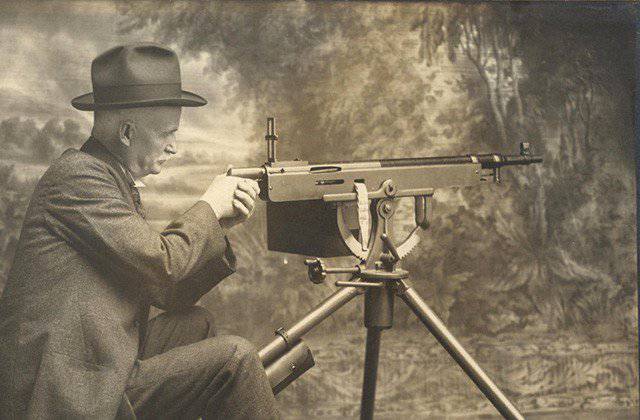
“Cowboy” machine gun in the trenches of the Russian front
American contribution armory Colt’s company (to be precise - Colt's Manufacturing Company) in the combat potential of the Russian army, of course, can be considered one of the “white spots” stories Great war. Although in the public mind, thanks to popular literature and cinema, the word "Colt" is firmly associated with cowboys and revolvers, in the Russian trenches it was well known thanks to a much more formidable weapon - the Colt M1895 / 1914 easel machine gun. The military department of the Russian empire for the needs of the army, they were purchased in very large volumes, and in terms of the number of trunks on the Russian front, this system was second only to the legendary "Maxim", produced in domestic factories. Deliveries of Colts from the United States made it possible, if not overcome, then, in any case, to significantly reduce the severity of the shortage of automatic weapons in Russian infantry formations.
In Soviet Russia, these machine guns did not stay long, since they were decommissioned almost immediately after the end of the Civil War. To a large extent, this contributed to the operational fragility of the barrel of the machine gun, a small supply of repair parts in warehouses, and most importantly - the reorientation of Soviet weapons production to create their own automatic weapons systems.
Originally from the Mormons
The creator of the machine gun Colt M1895 / 1914 was the famous American, and then the Belgian gunsmith John Moses Browning. It is noteworthy that the outstanding designer of small and automatic weapons, who received 128 patents for his life, was born into the family of American Mormon.
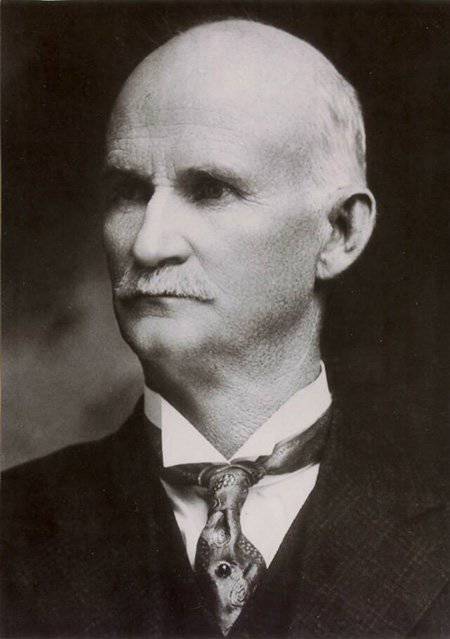
Jonathan Browning, the father of John Moses, was a convinced Mormon who moved to the state of Utah at the end of the nineteenth century in the nineteenth century. He had a 40 child from three wives, was an amateur and a weapons expert. In 22, with the support of the Mormon community, Jonathan Browning opened his own armory. Subsequently, John Moses Browning recalled that, constantly playing repaired weapons, he learned the name of parts, parts and mechanisms of different weapon systems before he learned to read.
In the literature literature there is an indication that John Browning designed his first single-shot rifle as a gift to Matt’s brother in 14 years. It is possible that in this case we should still be talking not about the design, but about the modernization of some already existing system, but a completely reliable fact is that Browning received its first weapon patent in 23 of the year. The single-shot rifle under this patent was given the name “JM Browning Single Shot Rifle” and began to be produced under the series “Model 1879 of the Year”. Later, Browning modified his first system and, under the serial name “Model 1885 of the Year,” the rifle is still manufactured in the USA.
As pointed out in his weapon case study (the only special Russian-language study on the Colt machine gun to date), S.L. Fedoseev, at the beginning of the 70-ies of the nineteenth century, Browning begins work on the "automation" of a multiply-charged rifle. The first design of a kind of "protopuleme" was made on the basis of the design of the Winchester M1843 magazine rifle with a swinging arm-clip for reloading. This rifle is well known to all fans of American "Westerns" with the participation of constant cowboys. Browning introduced a special mechanism into the device of the rifle, which removes part of the energy of powder gases for recharging when fired.
Due to the fact that the own weapons company of brothers John and Matt Browning "JM Browning & Bros" was financially and technologically weak, the idea of a gas recharge was proposed to the large arms company "Colt" for joint development. S.L. Fedoseev cites in his research an interesting entry from the diary of the head of the Colt's advanced development department, C. J. Ebets: “Today, 1891, June 10, two of the ten Browning brothers were here to discuss their machine gun, a model of which John had brought back on May 1. We agreed that we will try to implement the principle of using gas to drive the weapon mechanism as early as possible in order to get ahead of the claims to Maxim's priority. "
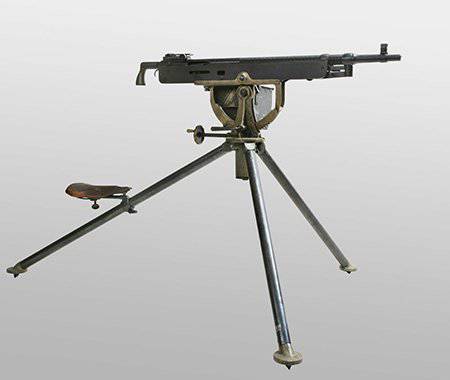
Speech in this note is about the gunsmith Hirama Maxim, the creator of the famous and most "long-circuited" in the military history of the easel machine gun "Maxim-Vikkers." As we see, the competition in the American market of inventions and the production of automatic weapons in the late nineteenth century was extremely acute. Different weapon firms went literally “nostril to nostril”, and the advantage in patenting did not exceed several weeks, and sometimes even days.
An application for patenting a machine gun developed at Colt was sent to the US Patent Office 3 August 1891. Over the next several years, the design of the machine gun was protected by three more patents. At the same time, work was under way to improve this automatic system and to set up the technological cycle in its industrial production.
The alliance of design thinking of John Browning and the financial capabilities of the company "Colt" eventually bore fruit: in 1896, the US Navy adopted the Colt M1895 machine gun chambered for 6-mm Lee. At about the same time, a small series of Colt M1895 machine guns in the version chambered for 30-40 Krag was acquired by the US Army.
For the first time, the Browning machine-gun was used in the battles of the US-Spanish 1898 conflict in Cuba. However, the Colt М1895 received a truly widespread use only during the Great War 1914-1918, and, oddly enough, in the Russian army. On the Russian front, unlike the American army, this machine gun became a truly mass weapon, the second in the total number of barrels after the machine gun of Hiram Maxim. The machine gun of the Russian defense order was upgraded (the trunk was strengthened, the machine was changed) and was let in under the heading Colt Model 1914.
In addition to Russia, the brainchild of Browning was purchased in relatively small series for the armed forces of Great Britain, Belgium and Italy. In the Italian army, the Colt M1895 was used the longest: right up to the end of 1943, these machine guns armed the units of the “second line” of defense, formed on the basis of the Mussolini volunteer organizations of the “black-shirts”.
Soldier's Potato Digger
John Browning, creating his first machine gun, tried, apparently, to simplify the system as much as possible, to make it repairable so that it could be repaired in front-line conditions with the help of the simplest tools - a hammer, a file and a wrench. Such a technical installation of the designer is seen in the mechanism of the gas engine of the machine gun, which is responsible for recharging the system, which was very simple and as accessible as possible to external repair.
The vast majority of gas-operated recharge systems are equipped with a linearly moving piston, which moves under the influence of the pressure of the powder gases in a special tubular gas chamber located either under the barrel of the weapon or above it. In modern weapon systems, a similar principle of the gas outlet is used very widely: under the barrel - in many developments of the Browning company (for example, in the Browning Bar II carbine), above the barrel - in the domestic Kalashnikov assault rifle and the Simonov Self-loading carbine (SKS), in a large family German rifles and machine guns Heckler & Koch.
The automatic reloading system for the Colt M1895 machine gun is fundamentally different. Powder gases when fired, passing a special gas outlet in the barrel, did not enter the closed chamber, but flew out into the atmosphere, after first striking the heel (short piston) of the rocking lever-rod. This lever, fixed at one end on the coupling under the barrel of the machine gun, produced a semicircular — back on 170˚ — movement in the lower rifle sphere, ejecting the spent cartridge, reloading the next cartridge, and charging the spring.
In the initial position of the lever-rod returned under the action of two return springs mounted in the guide tubes under the barrel. In this case, the bolt sent another cartridge to the barrel and, if the trigger remained pressed, the next shot occurred.
Since the main parts of the bolt group and the reloading mechanism consisted of levers and springs, almost all were visible, incomplete disassembly of the Colt M1895 machine gun and the replacement of individual elements of the system presented no problem.
The flip side of the medal of this scheme was the increased vibration of the barrel of the machine gun due to the long stroke movements of the levers attached to the barrel. Vibration has become an organic disadvantage of the Colt M1895 machine gun, and it was not possible to eliminate it by either a significant increase in the weight of the barrel or a massive tripod-type machine.
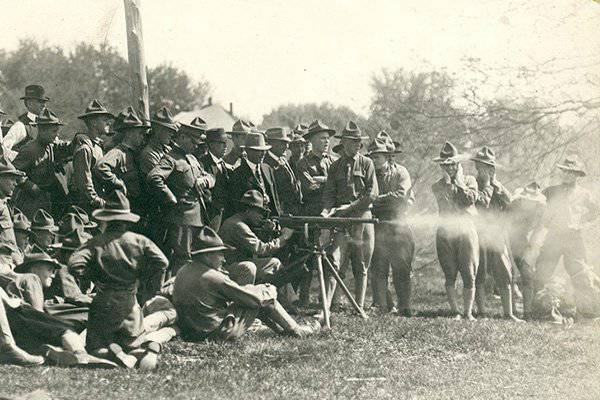
Shaking the barrel of the Colt most negatively affected the accuracy of firing from this machine gun, especially at long distances. Even experienced machine gunners, shooting from the Colt, could not show the results of accuracy, which were easily given when shooting from “Maxim”, “Lewis” and even “Madsen”.
The Colt М1895 had one more, very unpleasant in the conditions of the front, a feature: an excessively high profile. A machine gun mounted in a field on an unprepared platform instantly turned a fighter into a virtually semi-corps target. This feature of the "Colt" was determined by the need to have under the machine gun at least 15-20 centimeters of free space for the pendulum-like movement of the connecting rod. The movement of the lever under the machine gun eliminated the use of the Colt without a regular, rather high tripod machine.
Under field conditions, a specific clatter from the movement of the recharge levers, as well as clouds of dust, which rose from the powerful emission of powder gases into the lower hemisphere of the weapon, gave the Colt M1895, in the opinion of the soldiers, an external resemblance to a mechanical potato trowel. "Potato digger" - so called the brainchild of John Browning, the English-speaking soldiers. The name of this could occur, of course, only among the soldiers from the United States and Great Britain, where mechanical means of harvesting were used massively.
In the Russian Empire during the period of the Great War, the overwhelming majority of recruits from the peasants did not have the slightest idea of any kind of "potato digging". Therefore, in the Russian army, the Colt machine gun was sometimes called “the Bull” in everyday life - for its resemblance, apparently, with an angry bull who, in this state, vigorously throws dust and dirt on himself with his front hooves.
The machine gun was powered from a canvas ribbon on 100 and 250 (later versions) of ammunition. The Colt M1895 / 1914 was packaged with charging boxes and a “low tripod” machine gun designed specifically for a contract with the Russian military. The machine was very heavy - almost a kilo of 24. Together with the armor protective shield covering the arrow, the weight of the machine exceeded 36 kilograms. The weight of the machine gun was relatively small - 16,1 kilograms.
The transportability of the “Colt” even in comparison with the heavy machine “Maxim” was unsatisfactory. The machine-gun effort of two people, with urgent need, was enough to move and combat the use of "Maxim" on the battlefield. The Colt necessarily required at least three machine-gunners, otherwise, the machine gun moved to a new position risked remaining either without a tripod, or without an armor shield, or without ammunition.
American bulls on the Russian front
The staffing of infantry units of the Russian army with machine guns at the beginning of the Great War, to put it mildly, left much to be desired. In a specialized study of S.L. Fedoseyev said that at the end of 1914, the Russian army was supposed to have 4990 machine guns (for comparison, Germany had more than 12 thousand machine guns for the same period), but in reality, only 1 1914 barrels were delivered to the troops before 4 in August 157.
In June, the 1915 of the year, the Main Artillery Directorate of the General Staff (GAU) determined the monthly front demand for 800 machine guns, and in October of that year, the total army need for machine guns for January 1917 was planned within 31 170 units. These calculations, as indicated by the sources, were deliberately understated, because at the beginning of 1917, the front was supplied, due to extreme necessity, around 76 thousand machine guns. It is clear that a weak industrial base of the Russian Empire could not provide such a number of machine guns for the front.
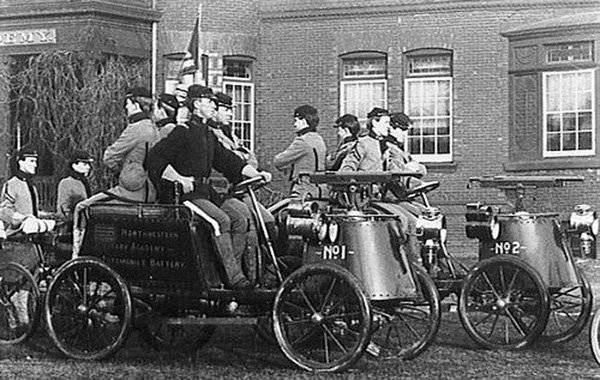
With the assistance of the British government in January 1915, the Russian State Air Administration placed an order for an installation series of one thousand Colts in the USA. The price of a piece in 650 dollars, according to modern experts, was clearly overestimated. However, in the future, in spite of significantly larger orders, the Americans invariably refused to revise the price downwards. Having missed the precious pre-war time, thinking more about building ambitious dreadnought battleships than about machine guns and artillery support for the ground forces, the Russian military department was now forced to generously pay the gold ruble to foreign manufacturers.
At the end of 1915 of the year, to the Chief Artillery Directorate of the General Staff, the British ceded their order in the USA for the 22 thousands of Maxim and Colt machineguns. At the beginning of the next 1916, the placement of orders for the manufacture of the Colt M1895 machine gun in the United States was continued. 29 January 1916 of the year, with the English mediation, a contract was signed with the American company Marlin-Rockwell Corporation for the supply of 12 thousand Colt machine guns under the Russian 7,62х54R rounding cartridge. The weapons for this order should have arrived in Russia no later than September 1916.
Almost simultaneously with the Marlin-Rockwell company, 10 of thousands of potato-sticks agreed to produce the Colt company by order of the Russian military. Subsequently, 28 of September 1916 was signed with Marlin, another one, this time the final contract for the 3000 Colt M1895 / 1914 machine guns.
The overwhelming majority of Colt machine guns were delivered to Russia substantially modernized. The barrel thickness was significantly increased, which made it possible to improve the ballistic indicators of the shot and increase the firing time to a dangerous warm-up of the barrel. The cares of the Russian emissary in the USA, Major General A.N. Sapozhnikova was reduced height of the machine-tripod, which somewhat reduced the vertical profile of the machine gun.
The “Colts” of the Russian order had a frame sight with a dioptric one entirely in the form of a disk with five holes and a scale on the 2300 m. The combat use of the Colt was uncomplicated: the sight disk was turned with a necessary hole (depending on the range and illumination) on the aiming line. The sight also had a rational mechanism for introducing lateral corrections (corrections for derivation - deflection of bullets when firing a rifle in the direction of rotation - were entered automatically when the shooting distance was set).
According to military experts, the Colt M1895 / 1914 was more agile when shooting at a prepared position than the Maxim machine gun. The brainchild of John Browning was probably the simplest from a technical point of view, the automatic system used in the battles of the Great War.
The machine gun "Colt" consisted of only 137 parts, of which only 10 screws and 17 springs. The Austrian Schwarzlose, almost perfectly simple for the machine gun, consisted of 166 parts. The British Vikkers (a deeply upgraded version of Maxim) were assembled from 198 parts, 16 screws and 14 springs. Russian "Maxim" of the model 1910 of the year (the design was subsequently simplified and the number of parts was reduced) had about 360 parts, 13 screws and 18 springs.
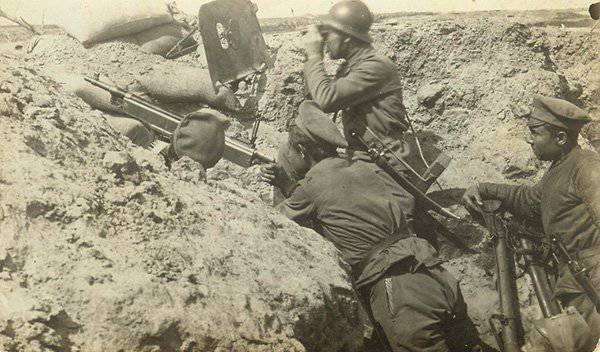
At the same time, in terms of operational survivability, the Colt machine gun could not even be closely compared with the Maxim, which had a liquid-cooled barrel. The first versions of the "Colt" in general could only fire in short bursts and for a very short time, because otherwise the barrel of the machine gun would become almost red hot and would become unusable. The “Russian version” of the Colt M1895 / 1914 machine gun, which received a thick barrel and transverse fins on it, could already shoot in long bursts, but also very briefly. With the fire from “Maxim”, the enemy’s attacking order could literally be “cast in” with lead.
The factor of insufficient operational durability of the barrel of the Colt, the relatively low rate of firing from it were, apparently, the reason that in the Russian army American machine guns did not enjoy the special love of soldiers. “On bezrybe and cancer - fish!” - A Russian proverb says: “Colt” machine gun was used only until it happened to change it to “Maxim” or “Lewis”.
Over the years of the war, 17 785 Colt machine guns were delivered to Russia, making this automatic system the second most common on the Russian front after the legendary Maxim. Despite the significant volume of deliveries from the USA, the Colt machine guns (as well as machine guns of other systems) in the front infantry formations were not enough even at the end of the war. On 1 March 1917, on four Russian fronts, the Colt machine gun was 2 433, while according to the staffing list there should have been at least 6 732 trunks in the troops.
Information